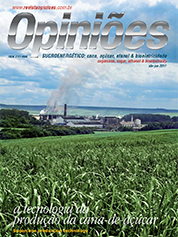Daniel Bachner
Global Director for Sugarcane at Syngenta
Op-AA-28
Sugarcane gains strength through technology
When one assesses the leap some crops have already made in productivity, one sees that there are still many opportunities with respect to sugarcane. In Latin America, from 1960 to 2008, crops such as corn, soybean, wheat and rice increased productivity in tons per hectare by more than 2.5 times, whereas sugarcane went from 49 tons to 80, i.e., 1.5 times.
This scenario encouraged Syngenta to raise its bet on the sugarcane-based industry, investing in creating an organization globally focused on sugarcane, with Brazil as its main reference. With the objective of making the country a center of excellence in this crop, the company will focus not only on providing answers for current challenges of planting sugarcane, such as mechanization, but also on developing sturdy and productive technologies and applying biotechnology to other plants.
The goal is to offer solutions for sugarcane plantations to be more productive and profitable, in order to significantly contribute to the social and environmental issue. In this context, we believe the mechanization of planting is one of the industry’s major challenges. The company’s most recent – and relevant – step in supporting the industry in this challenge is the Plene technology.
The starting point of this new system is the replacement of the traditional 40 cm billets with seed cane of only 4 cm, sourced in Syngenta-own nurseries and pre-protected by an industrial treatment against fungi and soil pests that damage the plant in the initial development phases, allowing for more robust growth and rendering planting much simpler.
Thus, the mill eliminates operations related to planting and cultivating in nurseries, while saving inputs, operation costs and labor. With seed cane supplied by Syngenta, the mill can add the area previously used by nurseries to the plantation area. This increase has direct reflexes in the volume of harvested sugarcane and also in the production of sugar, ethanol and bioelectricity. Additionally, an exclusive machine was developed to perform the planting operation of Plene seed cane.
Smaller and lighter, this planting equipment causes less soil compacting and has been adapted for direct planting. In this system, the placement of seed cane is more uniform than when the billets are distributed in the conventional way of planting, while also featuring more parallelism and using geo-referencing technologies. Given that it incorporates several operations in a single one, it makes planting more efficient, while doing away with several processes.
Efficiency also lies in using seed cane based on their quantity per hectare. Historically, this relation has been increasing in mechanical planting, reaching a demand of 18 tons of seed cane per hectare, or even more. Using Plene, there is a reduction to 2 tons per hectare, i.e., almost 90% less.
Another important aspect of this technology is the impact on harvestability, given that, because of deeper roots in comparison with the conventional planting, Plene plants have better resistance, because they have better sustentation. Plene’s positive impact begins at the individual level, in mills opting for this technology, but the repercussion is felt throughout the chain. The entire sugarcane-based market wins.
Considering the sugarcane industry’s growth potential, mainly because of global demand for renewable energy, this new technology may become an important differential for competitiveness. More than bringing plants’ potential to life, which is Syngenta’s main concept, Plene technology’s objective is to cooperate with the Brazilian sugar-cane-based industry to overcome its main planting challenges.
From looking for manpower, we will go on to qualification; upon reaching operational efficiency, we will be dedicated to efficiently using water and soil; the concern about sufficient quantities of seed cane will make room for incorporating new technologies; and lastly, once the definition phase on environmental legislation is concluded, our efforts to go about meeting the requirements of certification processes will gain momentum.




